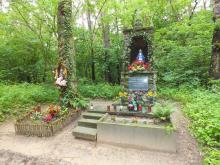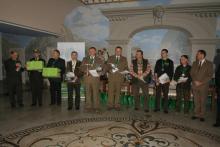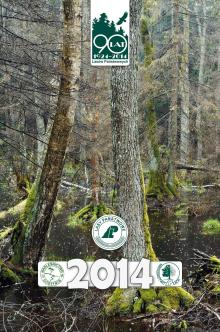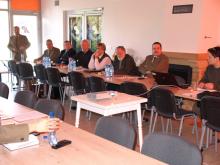 Asset Publisher
Asset Publisher
Polish forests
Poland is in the European lead, while concerning the area of all forests. They cover about 29,2 % of the country territory, and grow within the area of 9,1 million hectares. The overwhelming majority of the forests is state owned, of which almost 7,6 million hectares are managed by the State Forests National Forest Holding..
The number of Polish forest is still growing. The forestation rate of the country has increased from 21 % in 1945 to 29,2 % at the moment. Between 1995 and 2008, the forest area increased by 310 thousand ha. The basis for afforestation works is the "National Programme for Increasing the Forest Cover" (KPZL), assuming an increase of the forestation rate up to 30 % by 2020 and up to 33 % by 2050. Polish forests abound in flora, fauna and fungi. 65 % of the total number of animal species live there.
The forests grow in our country on poor soils, mainly because of the development of the agriculture in previous years. It influences the distribution of the types of the forest sites in Poland. Over 55 % of the forest areas is covered with coniferous forests. In other areas, there are forest sites, mainly the mixed ones. Their small part constitute alder and riparian forests – not more than 3 %.
In the years 1945 – 2011 the area of natural deciduous tree stands within the area of the State Forests National Forest Holding increased from 13 to 28,2 %.
Within the lowlands and uplands the most often occurring tee species is pine. It covers 64,3 % of the forest area of the State Forests National Forest Holding and 57,7 % of private and commune forests. In the mountains the predominant species is European spruce ( in the west) and European spruce with beech (in the east). Domination of pine is the result of carrying on sustainable forest management in the past. Once, the monocultures (crops or cultivations of one species) were the answer to the great demand of industry for wood. Such forests appeared to be quite fragile to climatic factors. They also were often the prey of pests' expansion.
In Polish forests, the share of other tree species, especially deciduous trees have been systematically increasing. The foresters have stepped aside from monocultures – that is why, they try to fit specific species of the forest stand to the natural stand, that would be proper for the given area. Thanks to that, in the years 1945 – 2011, the area of the deciduous tree stands within the lands of the State Forests National Forest Holding increased from 13 to 28,2 %. There occur more and more frequently the following tree species: oaks, ashes, maples, sycamore maples, elms, but also birches, beeches, alders, poplars, hornbeams, aspens, tilias and willows.
Our forests are the most often represented by the forest stands aged 40 to 80 years. The average age of the forest equals 60 years. More and more trees are of big size at the age over 80 years. Since the end of the Second World War, the forests' area has increased up to almost 1,85 million hectares.
Raport o stanie lasów w Polsce 2012
 Asset Publisher
Asset Publisher
Finał konkursu z DŁ
Finał konkursu z DŁ
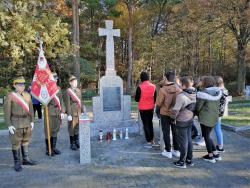 1 miejsce – Wiesława Kotecka - Szkoła Podstawowa im 17 Pułku Ułanów Wielkopolskich w Bielawach, klasa VII b
1 miejsce – Wiesława Kotecka - Szkoła Podstawowa im 17 Pułku Ułanów Wielkopolskich w Bielawach, klasa VII b
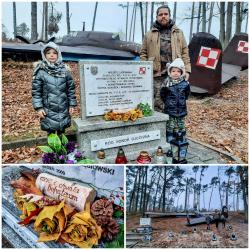 2 miejsce – Anna i Przemysław Wieczorek - Maria i Antonina Wieczorek
2 miejsce – Anna i Przemysław Wieczorek - Maria i Antonina Wieczorek
 3 miejsce – Monika Brzezińska - Julian Brzeziński, Gabriel Brzeziński
3 miejsce – Monika Brzezińska - Julian Brzeziński, Gabriel Brzeziński
 Wyróżnienie: Jacek Słupski_Hania i Łucja Słupskie
Wyróżnienie: Jacek Słupski_Hania i Łucja Słupskie
Konkurs „Pamiętajmy o Bohaterach” zakończony! Wspólnie z Dziennikiem Łódzkim, chcieliśmy zachęcić małych i dużych, aby odwiedzili leśne mogiły – Miejsca Pamięci Narodowej.
Jak drzewo bez korzeni, człowiek bez przeszłości, tak naród nie może istnieć bez historii... Najważniejsza jest pamięć o tych, którzy oddali życie za wolność Polski, dlatego w listopadzie zaprosiliśmy Państwa po raz drugi do udziału w akcji pn. PAMIĘTAJMY O BOHATERACH.
Lasy naszego regionu, które na co dzień kojarzą nam się z relaksem i bliskimi spotkaniami z przyrodą, pełne są pamiątek związanych z Powstaniem Styczniowym, a także z I i II wojną światową. Czasami są to nagrobne płyty pojedynczych lub zbiorowych mogił albo tablice pamiątkowe, innym razem ukryte wśród drzew kapliczki i krzyże... Licznie odwiedziliście te miejsca, poznając związane z nimi historie i oddaliście cześć bohaterom polskiej drogi do niepodległości!
Gratulujemy wszystkim uczestnikom!
Nagrody główne w konkursie otrzymali:
1 miejsce – Wiesława Kotecka z klasą VII b ze Szkoły Podstawowej im. 17 Pułku Ułanów Wielkopolskich w Bielawach
2 miejsce – Anna, Przemysław, Maria i Antonina Wieczorkowie
3 miejsce – Monika, Julian i Gabriel Brzezińscy
Wyróżnienie specjalne: Hania, Łucja i Jacek Słupscy
Pełna lista laureatów i galeria zdjęć dostępna na stronie: https://dzienniklodzki.pl/konkurs-pamietajmy-o-bohaterach-czyli-historia-zapisana-w-lasach-poznaj-ponad-50-miejsc-pamieci-narodowej-i-odwiedz-je-w/ga/c5-15245776/zd/53639087?fbclid=IwAR0N0_AT_8RDSyjQRLsSy2PV9zChdXkHTcpDbnwM3Xa6J3Xt40Yl9dUT9aM
Za sprawą konkursu chcieliśmy nakłonić do odwiedzenia Miejsc Pamięci Narodowej, zapoznania się z dramatycznymi historiami o zdeterminowanej walce o wolność oraz zachęcić do oddania hołdu bohaterom polskiej drogi do niepodległości. Chyba nam się to udaje, bo z roku na rok konkurs cieszy się coraz większym zainteresowaniem. Ciężko było wybrać laureatów – nadesłane odpowiedzi są bardzo budujące, zwłaszcza, że wielu uczestników to młode osoby.
Dziękujemy wszystkim, którzy wzięli udział w tej akcji. Dziękujemy za tę piękną, patriotyczną postawę i uczczenie pamięci bohaterów!
Pamięć o bohaterach pomagają też utrwalić nowoczesne formy przekazu, takie jak podcasty. Na stronie internetowej www.dzienniklodzki.pl/podcastyhistoryczne można wysłuchać i obejrzeć podcasty nagrane w ramach akcji z Dziennik Łódzki: o losach majora Henryka Dobrzańskiego Hubala i jego Wydzielonego Oddziału oraz o wojennych losach czterech sióstr, córek spalskich leśników, bohaterek wywiadu Armii Krajowej. W ramach akcji w 2021 powstał także e-book "Miejsca pamięci w lasach RDLP w Łodzi".
Zamieszczamy dodatkowe, edukacyjne materiały bezpośrednio poniżej - zapraszamy do słuchania i czytania!


 fot. Paweł Fabijański
fot. Paweł Fabijański
 fot. Paweł Fabijański
fot. Paweł Fabijański
 fot. Paweł Fabijański
fot. Paweł Fabijański


